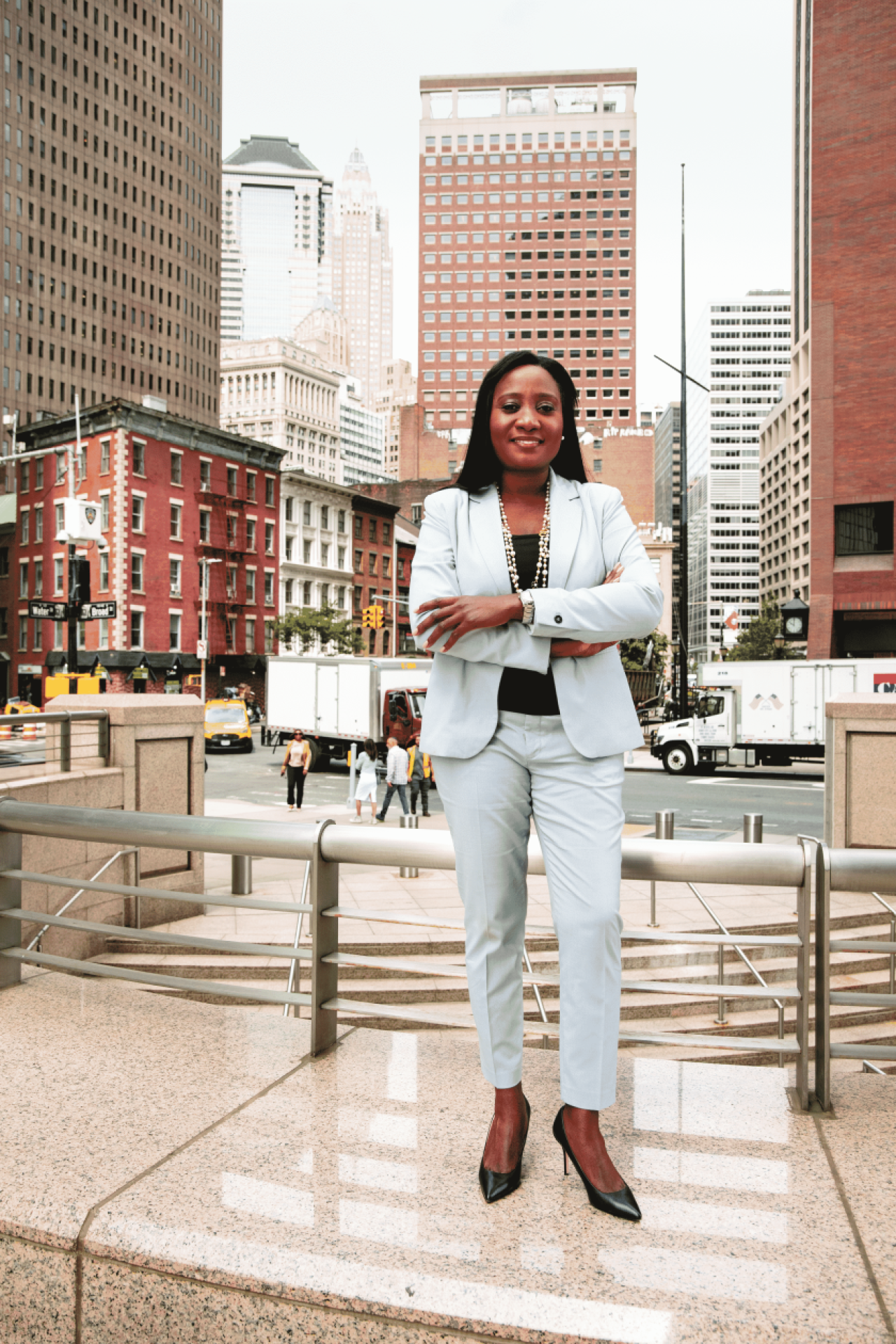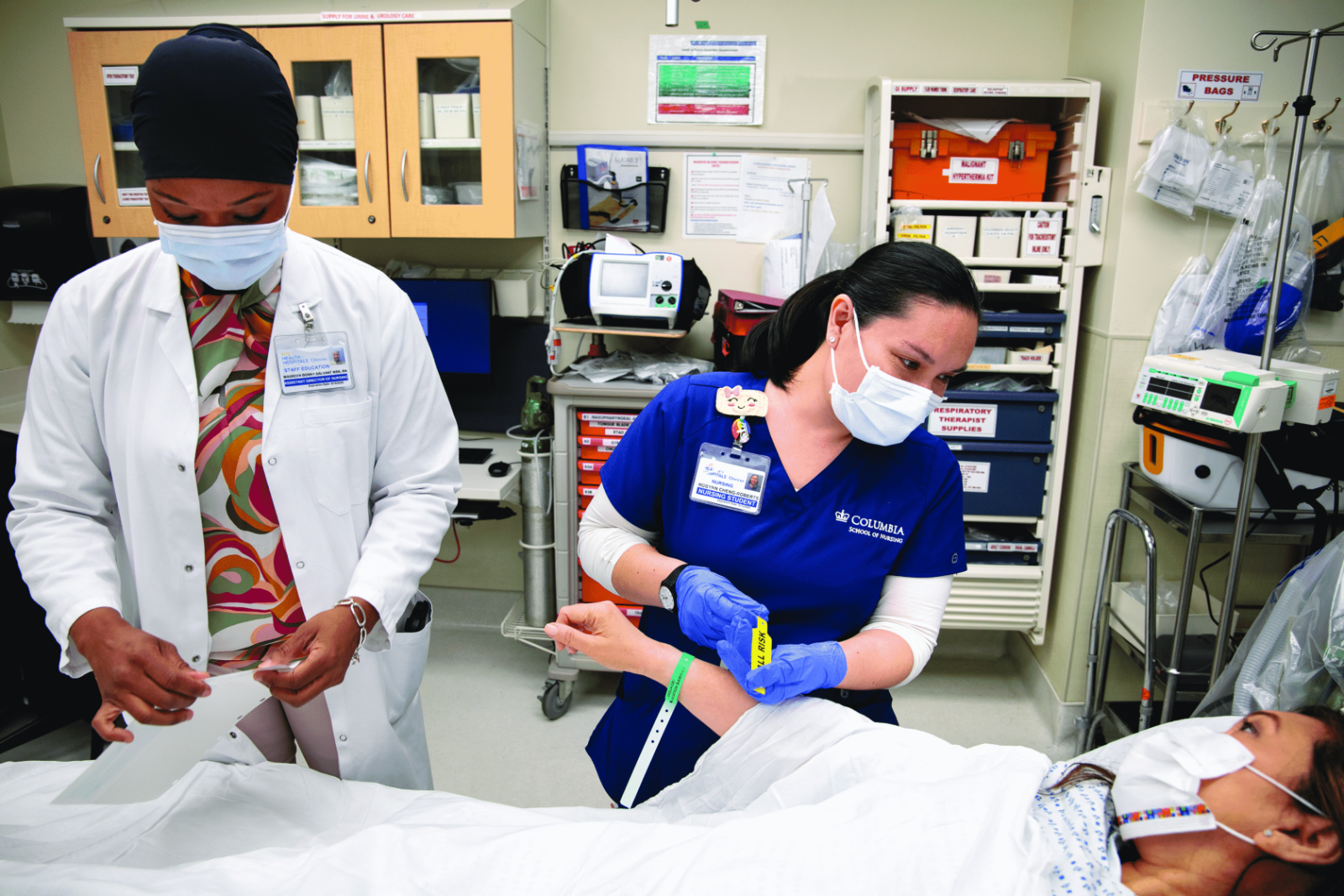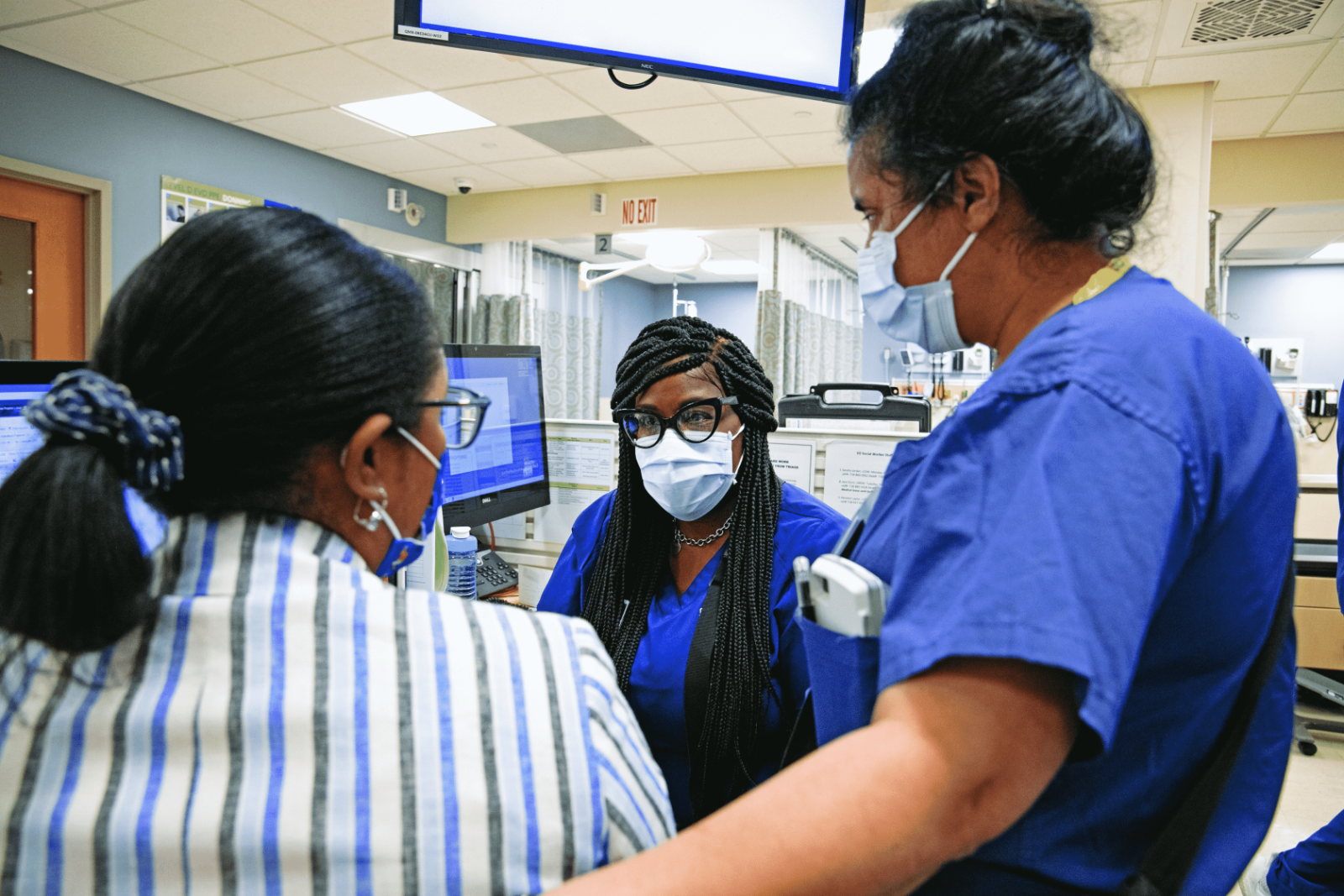When Laura Serna, MS '23, began her clinical integration experience at Queens Hospital Center last April, it felt like a kind of homecoming. Born in Colombia, Serna had immigrated to Astoria, Queens, with her family when she was 10 years old. As they struggled to gain a foothold in their new country, she and her loved ones relied on that facility and others operated by the New York City Health and Hospitals Corporation (which goes by both HHC and NYC Health + Hospitals) to treat their illnesses and injuries, deliver their babies, and provide preventive care. "We all have medical records there," Serna says.
HHC is the largest municipal health system in the United States, serving 1.4 million patients-mostly low-income or working-class people on Medicaid or Medicare. About one-third are uninsured, and many are undocumented. A public benefit corporation, HHC operates 11 acute care hospitals, five nursing homes, six diagnostic and treatment centers, and more than 70 primary care centers across New York's five boroughs. With a largely foreign-born patient population, it provides services in more than 200 languages.
In the spring of 2023, Columbia School of Nursing launched a partnership with HHC, enabling students in the Master's Direct Entry (MDE) Program to complete their required clinical integration at the Queens facility and three others affiliated with the HHC system: Harlem Hospital in Manhattan, Woodhull Medical Center in Brooklyn, and Lincoln Medical Center in the South Bronx. (Students can request placement at any of those facilities in the specialty of their choice.) Serna was one of 36 students who signed up for an HHC site when the option became available.
This quartet of facilities brings a new dimension to the integration program, an immersive clinical experience that is the capstone of the MDE curriculum. During the experience, students spend six weeks working one-on-one with preceptors (usually RNs) for three or four 12-hour shifts per week. Since its founding in the 1980s, the integration experience has been offered at a growing range of locations, including NewYork-Presbyterian and other private hospitals across the metropolitan area; the New York State Psychiatric Institute; Callen-Lorde, a group of clinics serving the city's LGBTQ+ community; the Bassett Healthcare Network, based in rural Cooperstown, New York; Memorial Sloan Kettering Cancer Center; and Columbia Nursing's 17 affiliated global sites.

Natalia Cineas, DNP
With the HHC sites added to the mix, students gained the opportunity to try their clinical wings in an urban public hospital system-one dedicated to providing "the highest quality health care services ... regardless of immigration status or ability to pay," as its website declares, and to creating "models of care that remove barriers for special populations experiencing a disproportionate burden of illness."
"NYC Health + Hospital's mission directly aligns with Columbia Nursing's focus on global health equity and on addressing the social determinants of health," says Heidi Hahn-Schroeder, DNP, assistant dean of academic affairs and director of the MDE program. "This partnership also advances a central part of the school's mission, which is to educate nurses to be leaders who can spearhead changes in health care that benefit patients and their communities."
A Mutually Beneficial Relationship
The partnership grew out of a longstanding link between Columbia Nursing and Natalia Cineas, DNP, a senior vice president and chief nurse executive for HHC and an adjunct faculty member at Columbia Nursing since 2015. Cineas took the reins at NYC Health + Hospitals in 2019, around the same time that Dean Lorraine Frazier, PhD, did so at the school.
Shortly afterward, Frazier, Hahn-Schroeder, and Judy Honig, DNP '05, EdD '95, the school's vice dean of academics and dean of students, met with Cineas to discuss ways in which the institutions could work together. "We started by sending a few students for rotations on an individual basis," Hahn-Schroeder explains. "But after COVID-19 spotlit the barriers to care facing underserved populations, we recognized that expanding the integration program to HHC hospitals would be a great way to provide students with the experience of caring for those populations."
The students were not the only ones who stood to benefit. "We want the best of the best caring for our patients," says Cineas. "These are students from a premier school who want to make a difference. They're committed, compassionate, innovative, and culturally sensitive. We hope some of them will come back and work with us after they graduate."

Robynn Cheng-Roberts, MS '23
Cineas also hopes that undergoing the integration experience at HHC sites will inspire some students to do nursing research aimed at improving care for underserved patients. And she credits Columbia Nursing's leadership with sharing her vision. "Columbia takes a slightly different approach from other schools," she notes. "The administration spends time and effort making sure that students' goals are aligned with our public health mission to address disadvantaged and vulnerable populations, rather than simply concentrating on the clinical placements. Focusing on the desire to help underserved patients and communities makes it likelier that those students will return to us-or seek out another public health care system with similar values-in the future."
A Career-Changing Experience
Among the inaugural class of students who did their integration at an HHC site, many described the experience as revelatory- and career-changing. That was the case for Robynn Cheng-Roberts, MS '23, a native of Southern California whose mother had immigrated from Taiwan. "Seeing her struggles with the health care system, as someone for whom English wasn't her first language and Western medicine wasn't her preferred form of care, made me want to make the system better and more accessible," says Cheng-Roberts, who has pursued that quest in various ways for more than a decade.
After college, Cheng-Roberts joined the Peace Corps and was posted to Honduras, where she managed a women's health initiative. Later, back in California, she did a stint with Planned Parenthood before returning to school to earn a master's in public health. She went on to work for the U.S. Centers for Disease Control and Prevention, the Chicago Department of Public Health, and a Manhattan-based global health nonprofit before enrolling at Columbia Nursing-drawn by a desire to do the kind of hands-on nursing she'd observed and admired in her earlier positions.
"We want the best caring for our patients," says Cineas. "These are students from a premier school who want to make a difference. They're committed, compassionate, innovative, and culturally sensitive."
Cheng-Roberts opted to complete her clinical integration in the Queens Hospital Center emergency department (ED). Her motivation was personal as well as professional: She'd lived in the borough since moving to New York, and she missed the sense of connection with her community that she'd known in Honduras. "There's a huge difference between supporting the health of people in distant lands and people in your neighborhood," she explains. "I wanted to feel closer to the folks around me."
At the HHC facility, situated in the most polyglot quarter of the city, she experienced that closeness in spades. "Work-leading at Queens Hospital was like doing a global integration in my backyard," she says. "I loved the diversity of both the patients and the staff." Shadowing her Nigerian-born preceptor on the 11 a.m.-to-11 p.m. shift, Cheng-Roberts helped relieve nurses in almost every section of the ED, including the acute, observation, pediatric, and pediatric psych units. "They were incredibly welcoming. Everyone was willing to teach me something and show me something."

Belinda Samuda, MS '23
She also encountered the full array of health challenges faced by the local patient population. "It was the good, the bad, and the ugly," Cheng-Roberts recalls. At times, the ED grew overcrowded and chaotic-in part, because it also provides nonemergency care for people who can't afford any other option. She was glad to be able to use her Spanish-language skills to comfort crying children as she inserted IV lines or to explain procedures to their worried parents. But when patients experiencing substance withdrawal lashed out at staff and had to be subdued by hospital police, all she could do was watch in dismay. "I knew about the opioid crisis," she says, "but to see people coming in agitated or violent, and needing much more support than an ED can offer, was a difficult thing."
The integration intensified Cheng-Roberts's drive to work for both on-the-ground and systemic change to reduce health care disparities. And it heightened her awareness of the skills she will need to pursue those goals. Although she went into the MDE program expecting to go on directly to complete her DNP, she decided instead to work as an RN for a year after completing her master's. "My time at this hospital made me realize there's a lot to learn," she says.
Lessons for the Future
Even at the same facility, however, different students can emerge with different lessons-drawn from their own personal history, temperament, and inclinations.
Take Belinda Samuda, MS '23. Born in Brooklyn and raised in Harlem, Samuda had built a career as a public interest and labor attorney for New York City before discovering her true calling. What changed her trajectory was taking a few years off to care for her mother, who was suffering from vascular dementia. "I started to think, 'I would like to emulate the good nurses I've met on my caretaking journey,'" she recalls. "Maybe I have a spiritual gift for it." After her mother's death, she earned her nursing school prerequisites at a community college, while becoming the assistant director of a multi-million-dollar day habilitation program for disabled adults. Then, searching for more effective ways to leverage her passions for caregiving, leadership, regulatory law, and social justice, she enrolled at Columbia Nursing.
By the time she started her clinical integration at the Queens ED, Samuda had resolved to specialize in psychiatric nursing. "During my Psych rotation, I'd discovered that I loved listening to patients' stories," she explains. Nonetheless, she'd always wondered what happened behind the scenes in an ED and was eager to experience nursing within that setting.
Samuda enjoyed learning the lexicon, protocols, and shortcuts of this high-pressure branch of the profession. "In the emergency room, it's all about timing," she says. "You've got to know what you need. You've got to know where things are and get them pretty quick." She was thrilled to watch seasoned nurses put into practice the abstractions she'd learned in the classroom, such as the importance of checking and stabilizing a patient's airway, breathing, and circulation the moment they arrive. "There's nothing more distressing than seeing a person coming in on a stretcher who can't breathe. It's like, 'Okay, I get it now!'"
She was also struck by how comfortable she felt with the culture of the ED. Like Samuda, most of the staff as well as the patients were people of color (the reverse of the ratio at the private hospitals where she'd done clinical rotations). Working the night shift, she was energized by the constant bustle and clamor. "I'm an inner-city person," she says with a laugh. "I like gritty. I like loud." As a former prosecutor, she even found a certain familiarity in seeing patients under custody. "It could have been jarring to others because it's a lot to take in. But for me, it was 'This is home.'"
In short, Samuda found her HHC integration to be "a wonderful, wonderful experience." It didn't change her plan to move directly into her DNP studies after completing her MSN, but she's rethinking her next step after that. Before committing to the world of mental health, she says, she may spend a couple of years amassing more medical experience-which could include time working in an ED.
Eventually, she expects to end up in an administrative leadership position, where she'll bring all of her learning and professional experience to bear. "That's just who I am," she says.
Giving Back
For Laura Serna, choosing the Queens ED for her clinical integration was a no-brainer. It wasn't just that she'd grown up in the borough, still lived there, and had been treated at local HHC hospitals since childhood; she also felt a duty to help community members who were struggling as she and her family once had. "Both of my parents were committed to public service," says Serna, the daughter
of a nurse and a worker-safety instructor. "So, naturally, I was inclined to that as well."
That impulse had led her to Columbia Nursing in the first place, and it drove her during her integration, too. "My biggest challenge was learning how not to be in the way," says Serna, who worked the 7 a.m.-to-7 p.m. shift in the acute section of the ED. "Fortunately, my preceptor was a real badass. She'd been a nurse for about 15 years, and it was amazing to watch her work. She was so efficient-she would have the patient undressed, blood drawn, on a monitor, IV line installed, in under 10 minutes. She gave me pointers on how to prioritize, how to think."
While these lessons were invaluable, the high points for Serna were the moments when she could comfort patients who felt vulnerable due to their position in society-people for whom even a minor medical emergency could threaten their ability to support themselves and their dependents.
One day, she found herself translating for a Spanish-speaking man who'd arrived by ambulance after injuring his back on a construction site. "He was afraid he was going to lose his job," Serna says, "which is very common when you're undocumented and you take time off for medical reasons. I was able to not only to give him the care he needed, but to calm him down emotionally. I told him, 'It's not your fault, you're not a bad person. You just need to get better.'" She gave the man a list of immigrant aid organizations and told him to keep in touch. "I felt for him. It brought back memories of how my parents worked so hard, and how they were always afraid when we first moved here."
Samuda enjoyed learning the lexicon, protocols, and shortcuts of the ED. "In the emergency room, it's all about timing," she says. "You've got to know what you need. You've got to know where things are."
Serna had long dreamed of becoming an emergency room nurse, and her clinical integration strongly reinforced that ambition. But she'd also been drawn to the idea of becoming a family nurse practitioner (FNP), and she felt torn by the idea of choosing one career path over another. "I'd heard people say that family practitioners don't work in hospitals," she says. "I was on the fence."
So she asked some nurses and doctors at the Queens ED and learned she'd heard wrong. "They told me I could be an FNP and work in the ED," says Serna. "They said I could do whatever I wanted."
That sense of possibility may have been the most important lesson she took away from her six weeks at the HHC facility. She decided to go right on to Columbia Nursing's FNP program. And she plans to apply for a job with HHC when she finishes.
Photographs by Jörg Meyer
This article originally appeared in the Fall 2023 issue of Columbia Nursing Magazine.






